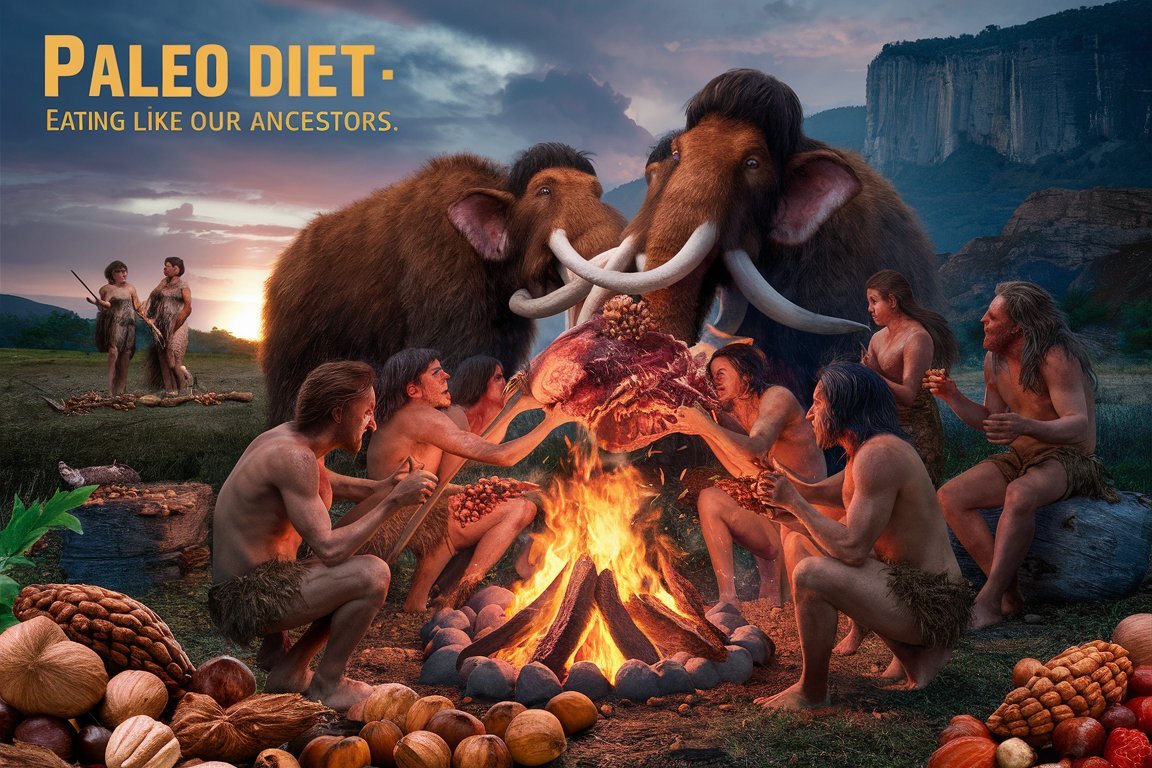The Paleo Diet: Eating Like Our Ancestors

Hey there, my young and curious friends of 2024! It’s your favorite nutrition adventurer, Nita Sharda, here to take you on an exciting journey back in time to explore the world of the Paleo diet. Now, I know what you might be thinking – “Paleo diet? That sounds like something only cavemen would do!” But trust me, understanding the principles behind the Paleo diet can help us make healthier food choices in our modern world.
Today, we’re going to put on our time-traveling hats and discover what it means to eat like our ancestors. But before we dive in, let me make one thing clear – this is not about putting anyone on a strict diet or making them feel bad about what they eat. It’s simply about empowering you with the knowledge and tools to make informed choices about your eating habits, now and in the future.
So, are you ready to embark on this prehistoric culinary adventure with me? Let’s go!
What is the Paleo Diet?
First things first, let’s talk about what the Paleo diet actually is. The Paleo diet, short for Paleolithic diet, is a way of eating that is based on the foods that our ancient ancestors would have consumed during the Paleolithic era, which lasted from about 2.5 million to 10,000 years ago.
During this time, our ancestors were hunter-gatherers, which means they relied on hunting animals and gathering plants for their food. They didn’t have access to modern conveniences like grocery stores, fast food restaurants, or processed snacks. Instead, they ate a diet that was rich in whole, unprocessed foods like meat, fish, fruits, vegetables, nuts, and seeds.
The idea behind the Paleo diet is that by eating like our ancestors, we can improve our health and well-being. Proponents of the diet believe that our bodies are genetically adapted to the foods that our ancestors ate, and that the modern Western diet, which is high in processed foods, sugar, and unhealthy fats, is a major contributor to chronic diseases like obesity, diabetes, and heart disease.
What Can You Eat on the Paleo Diet?
So, what exactly can you eat on the Paleo diet? Here’s a quick rundown of the foods that are typically included:
- Meat, poultry, and fish
- Eggs
- Fruits and vegetables
- Nuts and seeds
- Healthy fats, like avocado, olive oil, and coconut oil
Some Paleo diets also include small amounts of honey, maple syrup, and other natural sweeteners, as well as certain starchy vegetables like sweet potatoes and squash.
On the other hand, here are some foods that are typically excluded from the Paleo diet:
- Grains, like wheat, rice, and corn
- Legumes, like beans, lentils, and peanuts
- Dairy products, like milk, cheese, and yogurt
- Refined sugars and artificial sweeteners
- Processed foods, like chips, cookies, and candy
- Most vegetable oils, like canola and soybean oil
The idea behind these exclusions is that these foods were not part of our ancestors’ diets and may be difficult for our bodies to digest and process.
The Potential Benefits of the Paleo Diet
So, what are some of the potential benefits of following a Paleo diet? Here are a few that have been suggested by research:
1. Weight Loss
One of the most well-known potential benefits of the Paleo diet is weight loss. Because the diet emphasizes whole, unprocessed foods and eliminates many high-calorie, high-sugar foods, it can naturally lead to a reduction in calorie intake and promote weight loss.
Some studies have found that people who follow a Paleo diet tend to lose more weight and body fat than those who follow other types of diets, like low-fat or Mediterranean diets.
2. Improved Blood Sugar Control
Another potential benefit of the Paleo diet is improved blood sugar control. Because the diet eliminates many foods that are high in refined carbohydrates and added sugars, it can help stabilize blood sugar levels and reduce the risk of insulin resistance and type 2 diabetes.
Some studies have found that people with type 2 diabetes who follow a Paleo diet experience significant improvements in blood sugar control and insulin sensitivity.
3. Reduced Inflammation
Inflammation is a natural immune response that helps our bodies fight off infections and heal injuries. However, when inflammation becomes chronic, it can contribute to a wide range of health problems, from heart disease to cancer.
Some research suggests that the Paleo diet may help reduce inflammation in the body by eliminating foods that are known to promote inflammation, like processed foods and vegetable oils, and emphasizing anti-inflammatory foods like fruits, vegetables, and omega-3 fatty acids.
4. Improved Heart Health
Heart disease is the leading cause of death worldwide, and diet plays a major role in heart health. Some studies have suggested that the Paleo diet may help improve heart health by reducing risk factors like high blood pressure, high cholesterol, and obesity.
One study found that people who followed a Paleo diet for two weeks experienced significant reductions in blood pressure, cholesterol levels, and triglycerides compared to those who followed a traditional American diet.
5. Increased Nutrient Density
Because the Paleo diet emphasizes whole, unprocessed foods like fruits, vegetables, and lean meats, it tends to be higher in nutrients than the typical Western diet. This means that people who follow a Paleo diet may be getting more vitamins, minerals, and other important nutrients that are essential for good health.
For example, the Paleo diet is typically high in vitamin C, which is important for immune function and skin health, and vitamin K2, which is important for bone health and blood clotting.
How to Follow the Paleo Diet
Okay, so now that we know some of the potential benefits of the Paleo diet, let’s talk about how to actually follow it. Here are some tips to get you started:
1. Focus on Whole, Unprocessed Foods
The foundation of the Paleo diet is whole, unprocessed foods. This means choosing foods that are as close to their natural state as possible, like fresh fruits and vegetables, lean meats, and nuts and seeds.
Try to avoid processed foods like chips, cookies, and frozen dinners, which are often high in unhealthy fats, added sugars, and artificial ingredients.
2. Incorporate Plenty of Fruits and Vegetables
Fruits and vegetables are an important part of the Paleo diet, as they provide essential vitamins, minerals, and fiber. Aim to include a variety of colorful fruits and veggies in your meals and snacks throughout the day.
Some great Paleo-friendly options include berries, citrus fruits, leafy greens, broccoli, cauliflower, and sweet potatoes.
3. Choose Lean Proteins
Protein is an important nutrient for building and repairing tissues in the body, and the Paleo diet emphasizes lean proteins like meat, poultry, and fish.
When choosing animal proteins, opt for grass-fed or pasture-raised options whenever possible, as these tend to be higher in beneficial nutrients like omega-3 fatty acids.
4. Incorporate Healthy Fats
Healthy fats are an important part of the Paleo diet, as they provide energy, support brain health, and help absorb fat-soluble vitamins.
Some great sources of healthy fats on the Paleo diet include avocados, nuts and seeds, olive oil, and coconut oil.
5. Plan and Prepare Meals in Advance
One of the challenges of following a Paleo diet can be finding Paleo-friendly options when eating out or on the go. To make it easier to stick to the diet, try planning and preparing meals in advance.
You can batch cook Paleo-friendly meals like stir-fries, soups, and salads, and store them in the fridge or freezer for easy reheating later in the week.
Paleo Diet Meal Ideas
Need some inspiration for Paleo-friendly meals? Here are a few ideas to get you started:
1. Breakfast
- Scrambled eggs with sautéed spinach and avocado
- Paleo granola with almond milk and fresh berries
- Sweet potato hash with sausage and onions
2. Lunch
- Tuna salad with mixed greens and cherry tomatoes
- Grilled chicken with roasted vegetables and avocado
- Paleo “sandwich” with lettuce wraps, turkey, and mustard
3. Dinner
- Grilled salmon with asparagus and sweet potato wedges
- Beef stir-fry with broccoli, carrots, and cauliflower rice
- Paleo chili with ground beef, tomatoes













Leave a Reply